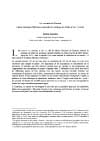XXVIth dynasty
« La demeure de Min maĂ®tre d’Imet. Un monument de Tell Farâoun rĂ©interprĂ©tĂ© »
ENiM 2, 2009, p. 103-108.
 Un nouvel examen de blocs de granite découverts à Tell Farâoun/Nebesheh par Petrie permet de préciser l’attribution du petit temple de l’ancienne ville d’Imet. Leur identification à deux montants de porte confirme la première impression que pouvait laisser la configuration des lieux, à savoir que le petit temple d’Imet ne serait pas la demeure de la déesse principale, Ouadjet dame d’Imet, mais celle de Min. L’époque à laquelle remonte ce temple, parfaitement daté par un dépôt de fondation du roi Amasis (XXVIe dyn.), correspond à celle où le dieu Min d’Imet apparaît dans la documentation.
Un nouvel examen de blocs de granite découverts à Tell Farâoun/Nebesheh par Petrie permet de préciser l’attribution du petit temple de l’ancienne ville d’Imet. Leur identification à deux montants de porte confirme la première impression que pouvait laisser la configuration des lieux, à savoir que le petit temple d’Imet ne serait pas la demeure de la déesse principale, Ouadjet dame d’Imet, mais celle de Min. L’époque à laquelle remonte ce temple, parfaitement daté par un dépôt de fondation du roi Amasis (XXVIe dyn.), correspond à celle où le dieu Min d’Imet apparaît dans la documentation.
 The reconsideration of granite fragments unearthed by Petrie at Tell Farʿun / Nebesheh allows us to clarify the attribution of the small temple of the ancient town of Imet. Their identification to two door-jambs confirms the first impression that could give the field, namely that the small temple is not the place of worship of Wadjet of Imet, the main deity, but the one of Min. The date of the construction of this temple, given by a foundation deposit of Amasis (26th dyn.), coincides with the date of the apparition of Min of Imet in the documentation.
The reconsideration of granite fragments unearthed by Petrie at Tell Farʿun / Nebesheh allows us to clarify the attribution of the small temple of the ancient town of Imet. Their identification to two door-jambs confirms the first impression that could give the field, namely that the small temple is not the place of worship of Wadjet of Imet, the main deity, but the one of Min. The date of the construction of this temple, given by a foundation deposit of Amasis (26th dyn.), coincides with the date of the apparition of Min of Imet in the documentation.
 Consulter cet article (49884) -
Consulter cet article (49884) -  Télécharger cet article au format pdf (26674)
Télécharger cet article au format pdf (26674)
« Le cercueil de Peniou. MusĂ©e national d’Histoire naturelle de Santiago du Chili (no inv. 11.160) »
ENiM 2, 2009, p. 109-128.
 L’analyse du cercueil de Pȝ-n(y)-jw (XXXe dyn. – dĂ©but de l’époque ptolĂ©maĂŻque ; MusĂ©e d’histoire naturelle de Santiago du Chili – MNHN 11.160) permet de mettre en lumière l’emploi d’une boiserie en trompe-l’œil originale et son rapport avec diffĂ©rents motifs religieux, notamment deux figures d’Anubis anthropomorphe adoptant la posture ksw.
L’analyse du cercueil de Pȝ-n(y)-jw (XXXe dyn. – dĂ©but de l’époque ptolĂ©maĂŻque ; MusĂ©e d’histoire naturelle de Santiago du Chili – MNHN 11.160) permet de mettre en lumière l’emploi d’une boiserie en trompe-l’œil originale et son rapport avec diffĂ©rents motifs religieux, notamment deux figures d’Anubis anthropomorphe adoptant la posture ksw.
 The analysis of the Pȝ-n(y)-jw’s coffin (Dynasty 30 – Ptolemaic Period; Museo Nacional de Historia Natural, Santiago of Chile – MNHN 11.160) allows to throw a light on the use of an original woodwork in trompe l’oeil and his relationship with various religious motives, specially two anthropomorphic Anubis in the ksw posture.
The analysis of the Pȝ-n(y)-jw’s coffin (Dynasty 30 – Ptolemaic Period; Museo Nacional de Historia Natural, Santiago of Chile – MNHN 11.160) allows to throw a light on the use of an original woodwork in trompe l’oeil and his relationship with various religious motives, specially two anthropomorphic Anubis in the ksw posture.
 Consulter cet article (58758) -
Consulter cet article (58758) -  Télécharger cet article au format pdf (27619)
Télécharger cet article au format pdf (27619)
« Ă€ propos d’un titre spĂ©cifique d’après la documentation saĂŻte d’Oxyrhynchos »
ENiM 8, 2015, p. 1-9.
 Identification du titre jmy-nww transmis par la documentation écrite issue des fouilles d’el-Bahnasa / Oxyrhynchos.
Identification du titre jmy-nww transmis par la documentation écrite issue des fouilles d’el-Bahnasa / Oxyrhynchos.
 Identification of the title jmy-nww transmitted by the written sources from excavations in el-Bahnasa / Oxyrhynchus.
Identification of the title jmy-nww transmitted by the written sources from excavations in el-Bahnasa / Oxyrhynchus.
 Consulter cet article (49382) -
Consulter cet article (49382) -  Télécharger cet article au format pdf (25159)
Télécharger cet article au format pdf (25159)
ENiM 18 - 2025
5 article(s) - 2 avril 2025.
ENiM 1 à 18 (2008-2025) : 224 articles
4 616 265 téléchargements
9 327 515 consulations.
Index des auteurs

Mots clés

Derniers articles : 
Robert Steven Bianchi
Duplication and Continuity
(ENiM 18, p. 13-36 — 11 mars 2025) 
Frédéric Mougenot
Rénénoutet à la porte de la maison
(ENiM 18, p. 1-12 — 29 janvier 2025) 
CENiM - Mise en ligne des volumes Ă©puisĂ©s : 
 Anne-Sophie von BOMHARD DĂ©cans Ă©gyptiens, CENiM 23, Montpellier, 2020 — (2020)
Anne-Sophie von BOMHARD DĂ©cans Ă©gyptiens, CENiM 23, Montpellier, 2020 — (2020) 
 Jean-Claude Grenier L'Osiris ANTINOOS, CENiM 1, Montpellier, 2008 — (26 dĂ©cembre 2008)
Jean-Claude Grenier L'Osiris ANTINOOS, CENiM 1, Montpellier, 2008 — (26 dĂ©cembre 2008) 
TDENiM - Mise en ligne des volumes Ă©puisĂ©s : 
 Twitter
Twitter 3805052 visites - 4400 visite(s) aujourd’hui - 100 connecté(s)
© ENiM - Une revue d’égyptologie sur internet
Équipe Égypte Nilotique et Méditerranéenne - UMR 5140 - « Archéologie des Sociétés Méditerranéennes » (Cnrs) - Université Paul Valéry - Montpellier III
























 Contact
Contact
 Abonnez-vous !
Abonnez-vous ! Équipe Égypte Nilotique et Méditerranéenne
Équipe Égypte Nilotique et Méditerranéenne UMR 5140 « Archéologie des Sociétés Méditerranéennes » (Cnrs)
UMR 5140 « Archéologie des Sociétés Méditerranéennes » (Cnrs) Université Paul Valéry - Montpellier III
Université Paul Valéry - Montpellier III